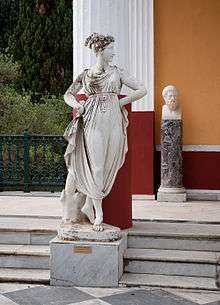Euphrosyne (mythology)


Euphrosyne (/juːˈfrɒzᵻniː/; Εὐφροσύνη), in ancient Greek religion, was one of the Charites, known in English as the "Three Graces". She was usually called Euthymia (Εὐθυμία).[1]
Greek mythology
According to Greek myth, Euphrosyne and the two other Charites were daughters of Zeus and the Oceanid Eurynome. The Greek poet Pindar states that these goddesses were created to fill the world with pleasant moments and good will. Usually the Graces attended the goddess of beauty Aphrodite and her companion Eros and loved dancing around in a circle to Apollo's divine music, together with the Nymphs and the Muses. She is usually depicted with her sisters.
Euphrosyne is a Goddess of Joy or Mirth, and the incarnation of grace and beauty. The other two Charites are Thalia (Good Cheer) and Aglaea (Beauty or Splendor). Her half-brother is Hephaistos, or Hephaestus, the god of metalworking and volcanoes. Her name is the female version of a Greek word euphrosynos, which means "merriment".[2]
In Roman myths the Graces where known as the Gratia.[3]
In art and literature
She can be seen along with the other two Graces at the left of the painting in Botticelli's Primavera. The sculptor Antonio Canova made a well-known piece in white marble representing the three Graces, in several copies including one for John Russell, 6th Duke of Bedford.[4]
John Milton invoked her in the poem L'Allegro.[5]
Cults of Euphrosyne
Euphrosyne and her sisters' main cult was located in Athens, Sparta, or Boetia.[6]
In science
The asteroid 31 Euphrosyne is named after the goddess, as is the Euphrosinidae family of marine worms.
References
- ↑ Pindar, Fragment 155
- ↑ "Theoi Greek Mythology & the Greek Gods". theoi.com. Retrieved 2016-08-30.
- ↑ the columbia encyclopedia fifth edition. 1993. p. 1117.
- ↑ The Three Graces. Victoria & Albert Museum, 2013. Retrieved 2 May 2013.
- ↑ "Milton, L'Allegro and Il Penseroso"
- ↑ "www.brittanica.com". Retrieved 2016-08-31.